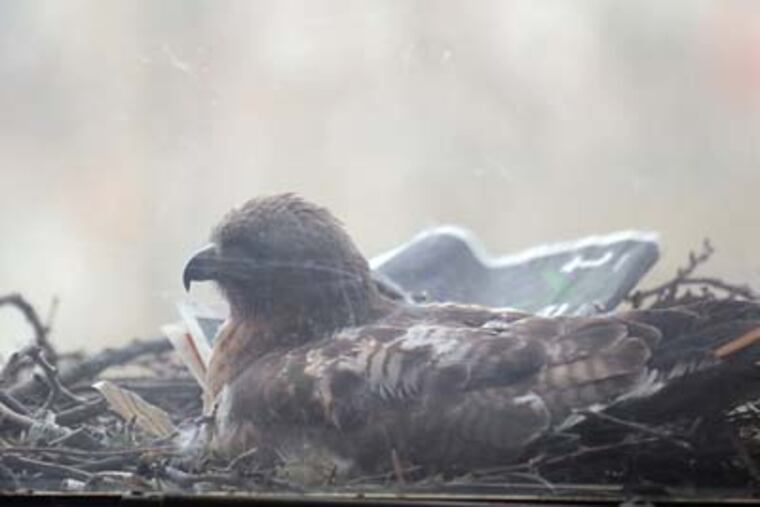Hawks nest on Franklin Institute's ledge
After three failed attempts at nest-building, the first egg appeared Monday. Yesterday, another came. It looks as if a pair of red-tailed hawks have moved to the Franklin Institute.

After three failed attempts at nest-building, the first egg appeared Monday.
Yesterday, another came.
It looks as if a pair of red-tailed hawks have moved to the Franklin Institute.
They have set up nest-keeping on a ledge outside the third-floor boardroom, and the news has set the staff abuzz. E-mail has been flying.
And now, there's a Web cam with streaming video, which as of yesterday was logging hits in the thousands, as the female positioned a bit of newspaper - with the crossword puzzle visible - around the eggs and then sat on them again.
"It's about as intimate an experience as one could get" with hawks, said the institute's president and CEO, Dennis Wint.
"Here in the middle of Philadelphia, having these wild birds nest on our building, that's about as cool as it gets."
As technology has advanced, Web cams have become a popular window on wildlife. They show the intimate secrets of eagles feeding their young, sea lions lolling on a beach, and pandas munching on bamboo at the National Zoo.
The National Audubon Society has a Web cam in Nebraska, surrounded by half a million migrating sandhill cranes, and another in Maine, just waiting for puffin breeding season to begin in May.
The camera is "nonintrusive to the birds, yet people feel like they're sitting by the nest," said Greg Butcher, director of bird conservation.
The departments of environmental protection in both Pennsylvania and New Jersey have falcon cams. Pennsylvania's cam is in its ninth year and has logged more than 34 million hits.
The fluffy chicks are Web celebs. One year, so many New Jersey "falcaholics" clicked in to a live banding Webcast that they stalled the state government server.
With nest season beginning again, New Jersey's cam has been activated and Pennsylvania's is due to be turned on within days. Biologists expect eggs - not to mention hordes of Web fans - within weeks.
Some cams have caught astonishing images. In 2007, a Pittsburgh falcon cam caught a bloody death battle 40 floors up between the resident male and an intruder.
Falcon cams - and eagle cams, of which there are plenty - are relatively easy because the birds return to the same spot to nest each year.
But hawks are more difficult because they sometimes move. Perhaps one of the first successful hawk cams was in 2004 at the Massachusetts Institute of Technology near Boston.
The birds happened to nest near the office of Larry Gallagher, director of video productions at MIT, and he was able to get a cam in place.
Mitsy and Kitty Hawk, as they came to be known, generated hundreds of comments on a blog, and once, when the camera momentarily went dark, calls flooded in.
The Franklin Institute hawks conveniently picked an accessible ledge. They began building their nest in July, but it kept falling off the building.
The last time it blew away - in full view of a staff meeting Jan. 12 - Wint decided it was time to help out.
Carpenters built a platform and replaced some of the sticks they managed to rescue from the sidewalk at Winter and 21st Streets.
It passed muster. The birds came back.
Just across the way, Doug Wechsler, director of visual resources for ornithology at the Academy of Natural Sciences, has been watching the hawks fly around Logan Square from his office window.
"It's a great place for pigeon-hunting," he said.
The nest itself doesn't signal much about the overall red-tailed hawk population, which unlike other raptors, has never been in a worrisome decline.
They're the most widespread hawk in North America, Wechsler said, found in just about every sort of habitat, from the edge of the tundra down into highland tropical forests in Panama, and deserts. And cities.
"It's a hawk that is doing extremely well in terms of coping with human intervention," he said.
About a decade ago, he said, hawks nested in a tree near Independence Mall. But it was also near a parking garage, and the territorial birds occasionally attacked people who dared park their cars on the roof.
Wechsler will be watching closely to see how the pair rear their young, and what they bring for food. Just pigeons? Or will they also offer rats and squirrels?
Hawks will lay up to five eggs, he said, so more may appear on the institute's cam.
The young will stay in the nest for six to seven weeks after that, then "fledge" - or learn to fly - for an additional eight weeks before they become independent.
For now, though, it will just be a matter of watching the female sit on the eggs.
In other words, Butcher said, "people have a few more weeks before it gets totally riveting, before they won't be able to do their work anymore."
Watch the Franklin Institute's red-tailed hawks - and falcons
in Harrisburg
and Jersey City - via bird cams: http://go.philly.com/earthEndText